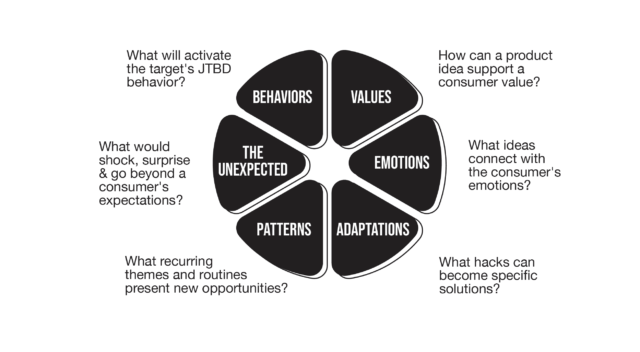One of the simplest ways to come up with good ideas is to push your team’s thinking beyond their current frameworks. To that end, we love this six points of ideation model for idea generation:

1. Behaviors—What will activate the target’s job to be done (Jobs To Be Done) behavior?
Or, stated a different way, what jobs are consumers hiring the new product to do for them? This is one of those straightforward elements that innovation teams are often thinking about. They have a strategy in mind such as “make our brand relevant in a new category,” and the goal everyone is tasked with is to develop a new product idea that activates a consumer behavior.
How do you make this happen? It’s not as simple as coming up with a good idea that consumers want. You have to go deeper into understanding who they are and what causes them to take action today. This can be done as easily in time-pressed focus groups as in ethnography work. The key is knowing how and where to dig and what to listen for as they describe their own points of activation. Jobs To Be Done strategy focuses on the “why” behind the consumer behavior, and as it was famously said, “People don’t want to buy a quarter-inch drill. They want a quarter-inch hole.”
2. Values – How can a product idea support a specific consumer value?
Consumers all come with a set of beliefs about the world and their movement within it. It’s the innovator’s task to clarify the nuances between the bold and broad statements they’ll provide you with in research to get at a more fundamental truth about their value system. We’ve done enough research on food products to know that “health” is a flexible and fungible value statement—a continuum of truth where foods fall on a scale of “more or less healthy.”
A mom who approves of their kids eating their favorite marshmallow cereal can describe its relative healthfulness in real and honest terms (e.g., “It’s much better than letting them have a candy bar. Healthiness is having them eat something over nothing. Sometimes that’s all we have in the house. They are healthy when they are happy.”), and so can a mom who only allows their kids to eat organic granola (e.g., “I want to see real ingredients in their breakfast. I think sugary cereals are bad for growing bodies. I like that some granola has chocolate chunks since that gets them to eat healthy.”).
Both products can bring roughly the same amount of sugar, carbs, fat, and whatever else you want to point out within the eating occasion, they just do it in different ways. The key is to peel back the onion on the values that people carry with them and see how it informs their choices so you can build ideas that serve the needs of your target best.
3. Emotions – What ideas connect with the consumer’s emotions?
Closely related to values is the consumer’s emotional link to things connected to the opportunity space. This includes things like the occasion (e.g., the midmorning pick-me-up), the ingredients (e.g., the warming effect of cinnamon), or even the brand itself (e.g., the nostalgia of a specific product line). They can all connect with the consumer on an emotional level. The key is to listen for those times when emotions pop out and inform the innovation opportunity, then build on or heighten those emotional aspects.
4. Adaptations – What hacks or workarounds can be turned into a specific solution?
One of our favorite pathways to innovation brainstorming and creation is to watch people customize, hack, or adapt something they already use. We all do it when cooking a meal. You may add more of this or less of that to make it exactly what you want. To watch consumers do this same process with a branded item is always fascinating. The key is to look beyond the specifics of the hacks to the intentionality of what they were trying to accomplish to inform new thinking.
5. Patterns – What recurring themes and routines present new opportunities?
We are all creatures of habit, and the way we return to products and engage with them speaks volumes. Those patterns indicate what feels comfortable and easy to adopt for your target audience. Does your target happen to control the size of their sweet treat after a meal by breaking their current cookies in half? Maybe your next cookie innovation needs to adapt to their patterns by offering cookie halves, bites, or muffin tops. The key is to look for patterns within the systems that make sense for your target and build or solve for those needs.
6. The Unexpected – What would shock, surprise, and go beyond a consumer’s expectations?
Sometimes a surprisingly ripe target for new product solutions comes from deeply investigating what would surprise, delight, shock, or go beyond the consumer’s expectations. For example, we have developed strong, winning ideas by taking a brand’s legacy and building it out a step or two. We worked on a traditionally kid-focused product where we took the brand to an adult space by adding adult flavor notes to the expansion. The adults resonated with their nostalgic brand suddenly filling a new space for them and were delighted.
The key is to push the boundaries to find those spaces that get a big reaction, then build on it or scale it back to the sweet spot as appropriate. This mind-blowing space can be a powerful, new place to play.
Contributed to Branding Strategy Insider by: Jonathan Tofel, author of Fire In The Machine: Driving Entrepreneurial Innovation In Large CPG Organizations
The Blake Project Can Help You Create A Bolder Competitive Future In The Jobs To Be Done Workshop
Branding Strategy Insider is a service of The Blake Project: A strategic brand consultancy specializing in Brand Research, Brand Strategy, Brand Growth and Brand Education




